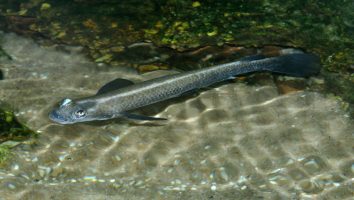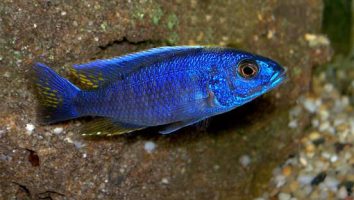The rummy-nose tetra is a peaceful and beautiful freshwater fish that is perfect for beginner aquarists.
This fish is relatively easy to care for and is very tolerant of different water conditions. They are also a very active fish and will add a lot of movement to your tank.
If you’re thinking about getting rummy-nose tetras, this guide will teach you everything you need to know about their care.
Table of contents
Species overview
Rummy-nose tetras (Hemigrammus rhodostomus) are found in a wide variety of freshwater habitats throughout South America.
They prefer areas with slow-moving water and plenty of vegetation. This provides them with plenty of places to hide and forage for food.
In the wild, these fish are omnivores and will eat a variety of plant matter and small invertebrates.
Rummy-nose tetras are very popular in the aquarium trade due to their bright red noses and overall peaceful nature. They make a great addition to most freshwater community tanks.
Appearance

The Rummy-nose tetra is a very thin and streamlined fish that is mostly transparent. The only real coloration on this fish is a bright red nose and a few red fins.
The fins on this fish are all very thin and delicate. The dorsal fin is short and begins right behind the head. The anal fin is a bit longer and starts right before the tail. The caudal and pectoral fins are both thin and long.
The tail on the Rummy-nose tetra is forked and extends outwards at a 45-degree angle.
This fish has a long and thin body that is mostly clear. The only exception to this is the bright red coloration on the nose and fins.
Lifespan
The average lifespan of a Rummy-nose tetra is around 5 years. These fish are generally very hardy, but there are a number of things that can shorten their lifespan.
As with any fish, water quality is extremely important. These fish are very sensitive to changes in water quality and even the slightest fluctuation can cause them stress.
Another thing to keep in mind is that Rummy-nose tetras are very active fish. They need a lot of space to swim and plenty of places to hide. A cramped or overcrowded tank will cause them a lot of stress and shorten their lifespan.
Size
The Rummy nose tetra is a small freshwater fish that only grows to be about 2.5 inches in length.
Tank
Tank Size
The recommended minimum tank size for Rummy-nose tetras is 20 gallons. This is assuming you’re keeping them in a school of at least 5 or 6 fish (which you should).
We personally recommend a slightly larger tank if you can accommodate it. Every extra space will make a big difference and allow you to keep a larger school or more tank mates if you’re interested in a community tank.
Water Parameters
The Rummy-nose tetra (Hemigrammus rhodostomus) is a peaceful, schooling fish that originates from the Rio Negro in South America. They’re a popular choice for freshwater aquariums because of their small size and unique coloration.
Rummy-nose tetras are very sensitive to changes in their environment. Because of this, it’s important to maintain consistent water parameters.
- Water temperature: 72 to 82 degrees Fahrenheit
- pH levels: 6.0 to 7.8
- Water hardness: 2 to 12 dGH
- Alkalinity Levels: 4-8 dKH
What To Put In Their Tank
Rummy-nose tetras are a freshwater species that originates from South America. In the wild, they can be found in slow-moving rivers and streams with plenty of vegetation.
When it comes to setting up an aquarium that meets their needs, there are a few key things to keep in mind.
First and foremost, these fish need a tank with plenty of hiding spots. We recommend using plants, rocks, and driftwood to create a labyrinth of hiding places for them. This will help reduce their stress levels and make them feel more at home.
The second thing to keep in mind is that these fish need soft, sandy substrate. A gravel substrate is too harsh for their delicate fins and can damage their barbells.
Finally, we recommend using a dimmer light fixture to help create a more natural environment for them. Rummy-nose tetras are shy fish and prefer to stick to the shadows.
Common Diseases
Rummy-nose tetras are a very hardy species of fish. They’re known for being quite resilient and able to withstand a lot of abuse.
However, that doesn’t mean that they can’t get sick. In fact, there are a few diseases that are relatively common in this species.
The most common disease that affects rummy-nose tetras is ich. This is a very contagious disease that is caused by a parasite. It’s most commonly spread by contact with other fish (or by using contaminated equipment).
The most obvious symptom of ich is the presence of white spots on the body, fins, and gills of your fish. If you notice this, it’s important to act fast.
There are a few other diseases that can affect rummy-nose tetras, but they’re not nearly as common. Some of these include bacterial infections, fungal infections, and parasites.
As with any other fish, the best way to prevent disease is by maintaining clean and stable water conditions. A well-maintained tank will go a long way in keeping your rummy-nose tetras healthy and disease-free.
Behavior & Temperament
Rummy-nose tetras are peaceful fish that do best in groups. They’re relatively active, but they’re not known for being particularly playful.
These fish like to stay close to the bottom of the tank and prefer dim lighting. They’re shy fish, so they may not come out to play if they feel like they’re being watched.
Rummy-nose tetras are schooling fish, which means they do best when they’re in groups. In the wild, they live in large schools of hundreds of fish. That’s why it’s best to keep at least six of them together.
If you don’t have enough room for a school of six, you should at least have three. That way, they can feel more secure and have the company they crave.
These fish are sensitive to changes in their environment. So, it’s best to slowly acclimate them to a new tank. Sudden changes in temperature or pH levels can be stressful and even deadly for these fish.
Tank Mates
Rummy-nose tetras are peaceful community fish that do well in groups. In the wild, these fish live in schools of hundreds of individuals.
In the home aquarium, a group of at least 6 is best. These fish are shy by nature and being in a group will make them feel more comfortable. It will also bring out their best colors.
When it comes to choosing tank mates, you have a lot of options. Rummy-nose tetras are compatible with most fish that occupy the middle or top of the water column.
Some good choices include:
- Neon Tetras
- Cardinal Tetras
- Corydoras Catfish
- Otocinclus Catfish
*Harlequin Rasboras
*Kuhli Loaches
Breeding
Rummy-nose tetras are a schooling fish that prefers to live in groups. In the wild, these fish are found in slow-moving rivers and streams in South America.
Rummy-nose tetras are easy to breed in captivity. These fish reach maturity at around 6 months of age. The easiest way to trigger spawning is to simply place a group of fish in a well-decorated tank with soft, slightly acidic water.
As long as the water quality is good and the fish are well-fed, they should start spawning on their own.
These fish are egg scatterers. The female will lay her eggs among the plants, and the male will fertilize them. Once the eggs are laid, the adults should be removed from the tank.
The eggs will hatch in about 24 hours. The fry will be very small, so you’ll need to feed them live foods like brine shrimp or bloodworms.
As they grow, you can start to introduce them to flake food and other small pellets.
Conclusion
The Rummy-nose tetra is a great fish for beginners and experienced aquarists alike. They’re easy to care for and have a beautiful, unique coloration that is sure to stand out in your tank.
They’re also a peaceful fish that will do well in a community tank.
Overall, we think the Rummy-nose tetra is a great choice for anyone looking for a new fish to add to their tank.












